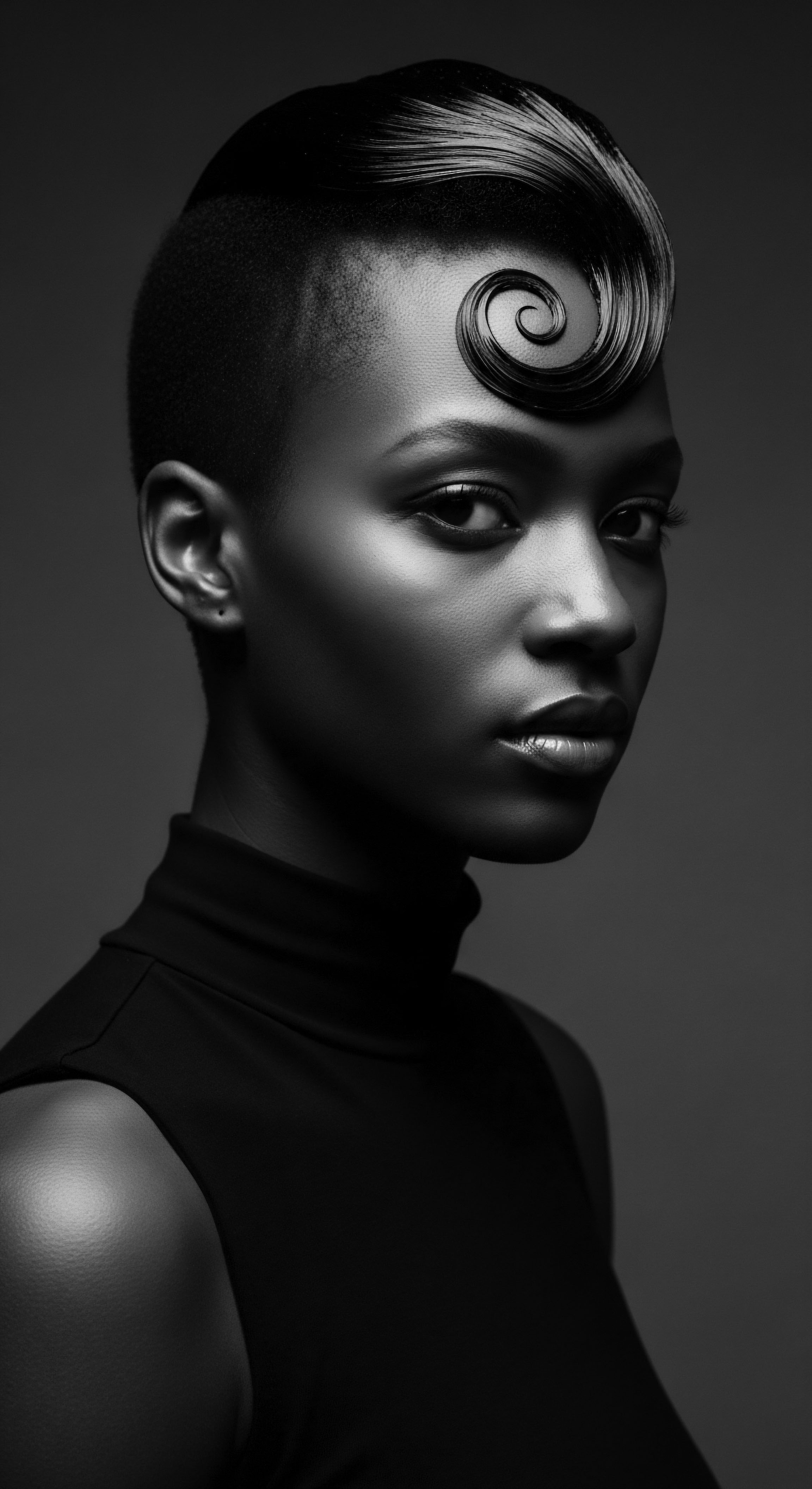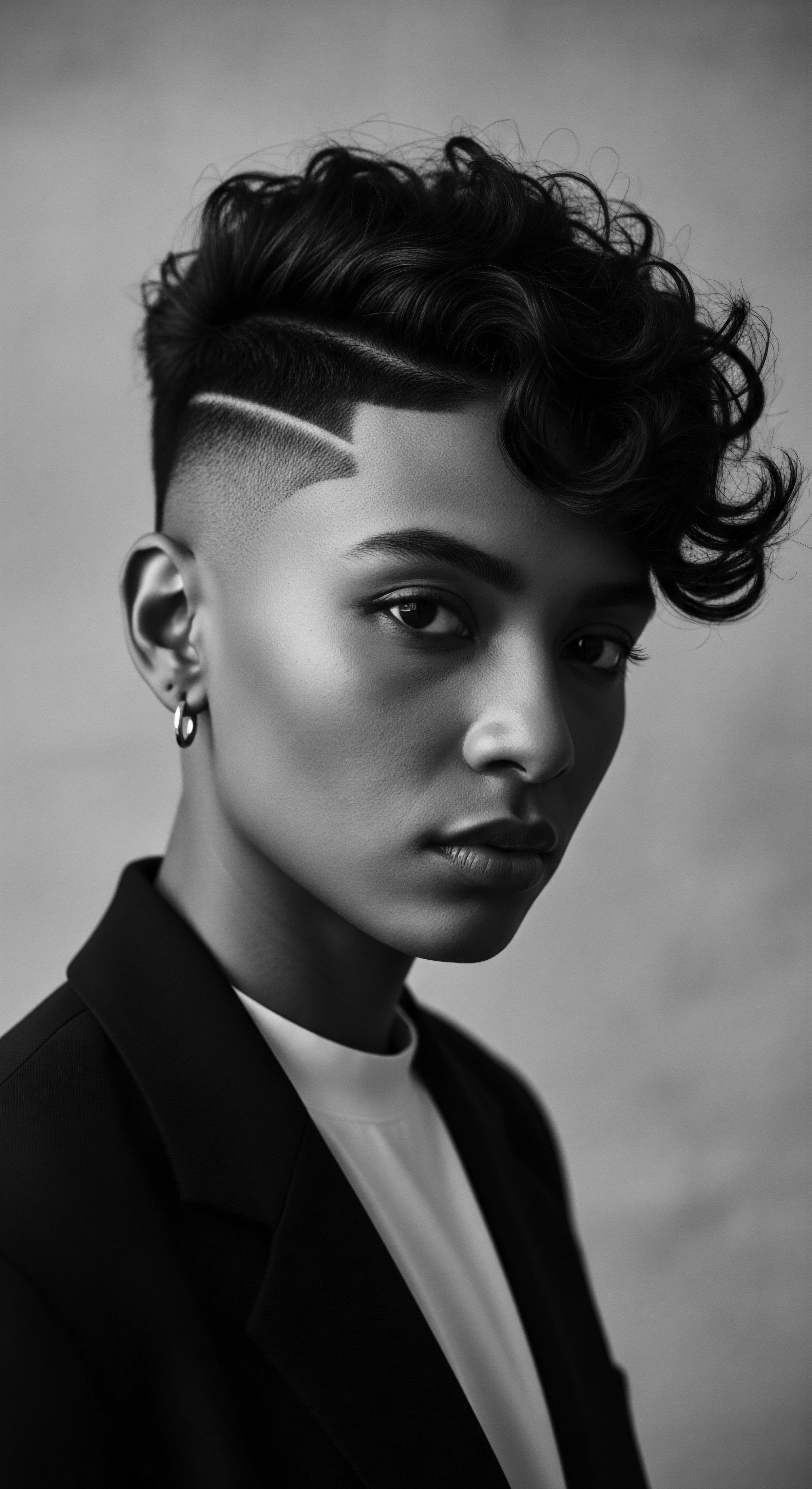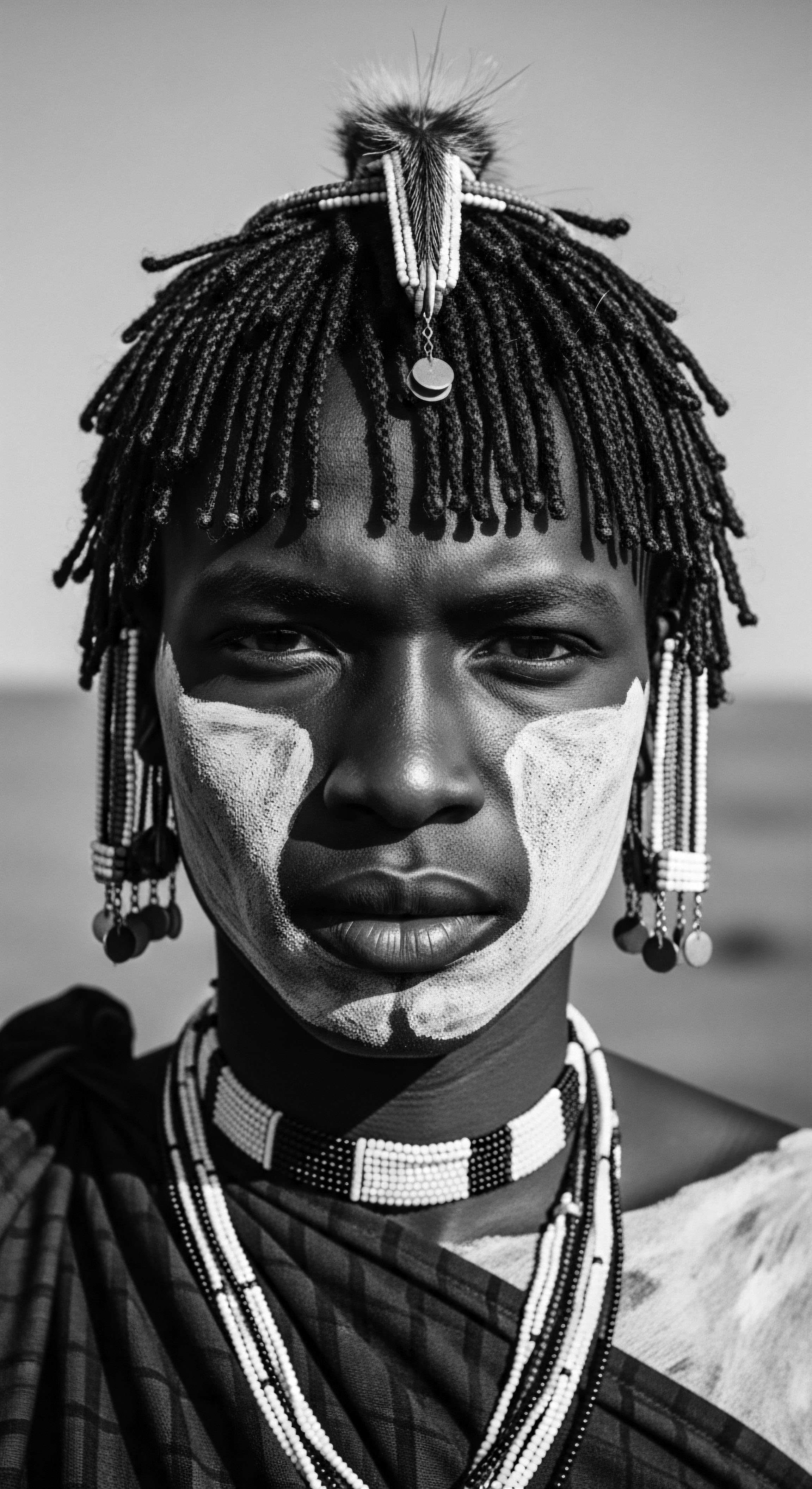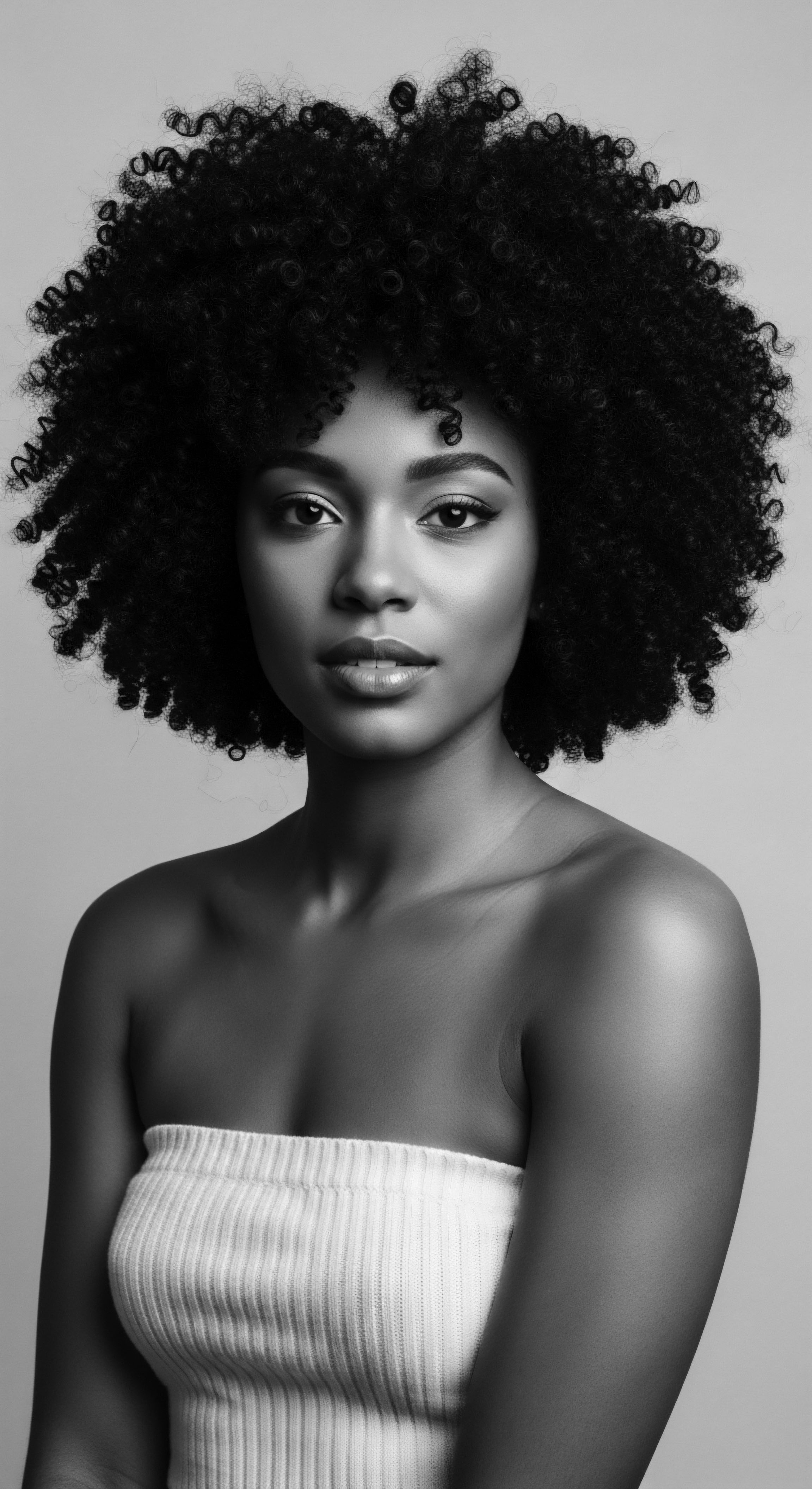
Roots
There exists a quiet hum, a resonance that travels through generations, whispering tales of coiled crowns and the hands that tended them. For those with textured hair , our strands are not merely biological filaments; they are archives, bearing the imprints of ancestral wisdom , resilience, and artistic expression. To ask whether traditional practices can offer solutions for modern textured hair challenges is to gaze into a living library, to acknowledge that the remedies we seek might already reside within the deep currents of our collective heritage . The journey into this inquiry begins at the very source, at the elemental understanding of textured hair itself, seen through the lens of ancient knowledge and contemporary science.

Hair Anatomy and Physiology Shared Through Ancestral Lenses
Textured hair, with its unique helical structure, presents a distinct set of characteristics that have been both celebrated and, at times, misunderstood throughout history. The very curl, coil, or wave pattern is a biological marvel, a testament to genetic diversity. While modern science details the precise arrangement of disulfide bonds and the elliptical cross-section of the hair shaft, ancestral communities long recognized these inherent qualities through observation and intuitive understanding. They observed how certain hair types reacted to moisture, to sun, or to various plant extracts, developing practices that honored these inherent properties without the need for microscopes or chemical analyses.
Consider the protective qualities of the scalp’s natural oils. For hair with more bends and twists, these natural emollients travel a longer, more circuitous path down the strand, making the ends more susceptible to dryness. Traditional care systems often addressed this with practices like regular oiling and sealing, ensuring that moisture was not merely applied but truly held within the hair’s fabric.
This ancestral insight into moisture retention—a cornerstone of modern textured hair care—was born from intimate familiarity with the hair itself, developed over countless generations of careful tending. It is a profound testament to the deep observational science practiced by our forebears.

Systems of Classification and Their Cultural Echoes
Contemporary hair typing systems, while useful for product formulation and personal understanding, often present a simplified framework. Historically, textured hair was not categorized by a numerical chart but by its connection to identity, status, and spiritual belief. Pre-colonial African societies, for example, used hairstyles to convey a person’s geographic origin, marital status, age, ethnic identity, religion, wealth, and rank. The very act of styling could tell a story, acting as a visual language to communicate an individual’s place within their community.
This historical context reveals a richer, more nuanced classification, one rooted in communal recognition rather than standardized measurement. A Fulani braid, a Maasai warrior’s adornment, or the coiled styles of ancient Egyptians all carried specific meanings beyond mere aesthetics. The language of textured hair, then, was not a universal metric but a localized dialect, understood and cherished within specific cultural groups. The question for us today is how to honor this historical complexity while seeking accessible solutions.
The deep patterns in textured hair whisper tales of identity and ancient community, revealing a language of belonging beyond simple categorization.
What traditional names for textured hair offer a connection to ancestral identity?
Many traditional cultures used names and descriptors for hair that were deeply tied to their environment, spirituality, or social structures. While a universal historical lexicon for textured hair classification across all African and diasporic communities is not readily available, specific groups used terms that conveyed status, age, or tribal affiliation through style. For instance, the Yoruba people of Nigeria used hairstyles, such as “Irun Kiko” (a form of thread-wrapping), to convey marital status and coming-of-age rites, viewing hair as sacred and a medium for spiritual energy.
The Maasai, in East Africa, identified their young warriors, or morans, by specific shaved and braided styles that symbolized strength and bravery. These examples demonstrate how hair nomenclature was intrinsically linked to social and spiritual identity, rather than solely curl pattern.

Hair Growth Cycles and Historical Influences
The rhythmic growth, resting, and shedding of hair is a biological constant, yet how people supported these cycles historically varied widely based on environment and available resources. In many traditional African societies, hair care was a patient, consistent practice, often utilizing indigenous ingredients harvested from the local ecosystem. The focus was on supporting the hair’s natural vitality, rather than forcing it into a desired state. Climate, diet, and community practices all shaped how these cycles were observed and supported.
For example, communities living in arid climates understood the vital need for moisture retention, employing plant-based oils and butters to protect hair from harsh elements. Their diets, rich in nutrient-dense foods, naturally supported healthy hair growth from within, a holistic approach that predates modern nutritional science. This integrated understanding of the body, environment, and hair, passed down through oral tradition and practical application, provided a sophisticated framework for hair health that modern practices are only now beginning to rediscover.
| Aspect of Hair Hair Structure |
| Traditional Understanding (Heritage Lens) Observed as varied textures, influencing how light reflects and moisture behaves; symbolic of lineage and identity. |
| Modern Scientific Understanding Understood as elliptical cross-sections, varied cuticle layers, and unique disulfide bond distribution leading to curl patterns. |
| Aspect of Hair Moisture Retention |
| Traditional Understanding (Heritage Lens) Recognized as a need for regular oiling and sealing due to hair's natural inclination to dryness, based on tactile experience and climate. |
| Modern Scientific Understanding Attributed to the open cuticle structure and limited spread of natural sebum along coiled strands. |
| Aspect of Hair Growth and Health |
| Traditional Understanding (Heritage Lens) Associated with a balanced diet, natural ingredients, and gentle handling; seen as a sign of overall well-being and ancestral favor. |
| Modern Scientific Understanding Correlated with genetics, nutrient intake, scalp health, and minimizing mechanical stress and chemical damage. |
| Aspect of Hair The continuity of understanding across time, from ancient observation to modern scientific inquiry, grounds our approach to textured hair. |

Ritual
The hands that shaped hair centuries ago were not merely engaged in styling; they were performing rituals, weaving stories, and preserving a legacy. These traditional practices were deeply rooted in communal life and held profound cultural meaning. The rhythm of a braiding session, the application of a nourishing balm, or the careful wrapping of a headtie transcended simple aesthetics, becoming acts of care, connection, and identity assertion. This deep historical context offers a powerful lens through which to consider the efficacy of traditional practices for modern textured hair challenges.

Protective Styling Ancestral Roots
Protective styling, a cornerstone of modern textured hair care, finds its deepest origins in ancestral African practices . These styles were not just about beauty; they served essential practical functions ❉ protecting hair from environmental damage, reducing manipulation, and preserving length. Braids, twists, and locs, seen today on red carpets and city streets, echo the meticulous work of hands millennia past.
Cornrows, for instance, date back to 3500 BCE, depicted in ancient rock paintings and Egyptian art. These styles were complex visual languages, conveying social status, age, marital status, and tribal affiliation.
During the transatlantic slave trade, when forced assimilation sought to erase cultural identity, these styles became acts of resistance and preservation . Enslaved Africans, stripped of their material possessions, carried their hair traditions as a powerful means of holding onto their heritage. Cornrows were even used to conceal seeds for planting in new lands or to map escape routes.
This profound history underscores that protective styles are more than just a technique; they are a living testament to resilience, a testament that continues to provide solutions for fragility and growth challenges in textured hair today. Minimizing manipulation, distributing tension, and protecting ends are core principles of these ancient methods that remain fundamentally sound.

Natural Styling and Heritage Methods
The pursuit of natural texture definition is not a modern trend but a return to practices long honored in ancestral communities . Before chemical straighteners became widespread, various methods were used to enhance and maintain natural curls and coils. These methods often involved the skillful use of water, natural oils, and specific manipulation techniques. The goal was to hydrate, clump, and elongate the natural pattern without resorting to harsh alterations.
Consider the practice of African threading , a method involving wrapping hair with thread to stretch and straighten it without heat. This technique, while not solely about definition, certainly allowed for a smoother, more manageable texture. Furthermore, the constant use of natural oils and butters like shea butter or marula oil, common in many African cultures, served to moisturize and condition hair, which naturally enhanced curl clumping and definition. These practices, passed down through generations, demonstrate an innate understanding of how to work with, rather than against, textured hair’s natural inclinations.
How did communal hair practices strengthen ancestral bonds?
The act of hair styling, especially braiding, was often a deeply communal and social activity in many African societies. These sessions were not just about getting hair done; they were gatherings for sharing stories, gossip, advice, and cultural knowledge. Mothers taught daughters, grandmothers guided younger generations, and friends strengthened their bonds through shared time and touch. This collective experience reinforced social structures, passed down traditions, and provided psychological support, making hair care a vital part of community cohesion and the transmission of cultural heritage .
Ancestral hair practices offer a blueprint for modern care, emphasizing protection, natural enhancement, and community connection.

Traditional Tool Innovations
The tools used in traditional hair care were often ingenious, born from necessity and a deep understanding of natural materials. Combs carved from wood or bone, simple yet effective, were designed to navigate coiled strands gently, minimizing breakage. While modern brushes boast ergonomic designs and specialized bristles, their ancestral counterparts performed the same function with thoughtful simplicity.
The invention of the African pick, for instance, re-emerged during the Civil Rights Movement as a symbol of Black pride and unity, though it had existed in Africa for centuries. These tools were crafted to work with, not against, the natural texture of hair, a principle that remains salient today.
- Wooden Combs ❉ Often wide-toothed and smooth, designed to detangle without snagging delicate coils. These were practical tools for daily care.
- Bone Picks ❉ Used for parting, lifting, and shaping, reflecting an intuitive understanding of hair manipulation for styling and health.
- Natural Fibers and Wraps ❉ Beyond aesthetics, head wraps, like the gele of West Africa or turbans in the Caribbean, protected hair from elements and served as symbols of dignity and resilience.
| Cultural Group/Region West African Communities (e.g. Fulani, Yoruba) |
| Traditional Tool(s) Wooden combs, specific braiding needles, natural fibers, beads, cowrie shells. |
| Technique / Purpose Intricate braiding (cornrows, box braids), thread-wrapping, adornment to signify status, age, or spiritual beliefs. |
| Cultural Group/Region East African Tribes (e.g. Maasai, Himba) |
| Traditional Tool(s) Ochre paste, butter/ghee, natural dyes, plant-based adornments, possibly bone tools. |
| Technique / Purpose Shaving, braiding, locing with natural compounds, for rites of passage, spiritual connection, and identity markers. |
| Cultural Group/Region African Diaspora (e.g. Caribbean, American) |
| Traditional Tool(s) Head wraps, inherited combs, repurposed items for styling. |
| Technique / Purpose Adaptation of braiding and twisting for protection and resistance, utilizing available materials. |
| Cultural Group/Region These varied approaches demonstrate a collective ingenuity in nurturing textured hair through diverse heritage contexts. |

Relay
The enduring wisdom of traditional practices reaches across time, a vital relay from our forebears to our present-day textured hair experiences. To fully grasp how these deep-rooted customs offer solutions for contemporary challenges, one must journey beyond surface-level observation, delving into the symbiotic relationship between ancestral methods and modern scientific understanding. This is where the historian, the wellness advocate, and the scientist converge, articulating how deep heritage can inform a sophisticated approach to care.

Building Personalized Regimens Rooted in Ancestral Wisdom
Creating a personalized textured hair regimen today often involves navigating a bewildering array of products and advice. Yet, the blueprint for a balanced approach already exists within ancestral wisdom . Traditional care was inherently holistic and individualized, shaped by localized environments, available resources, and intergenerational knowledge. There was no one-size-fits-all solution; instead, communities developed practices suited to their specific hair types and living conditions.
Consider the consistency of care. Traditional hair rituals were often daily or weekly occurrences, not sporadic treatments. This regular, gentle attention, coupled with the use of nourishing ingredients, naturally promoted healthy growth and reduced breakage. The focus was on maintaining the hair’s integrity from within, acknowledging its connection to overall well-being.
Today, this translates into establishing consistent wash days, moisturizing routines, and protective styling schedules that honor the hair’s need for continuity. Our ancestors understood that healthy hair was a testament to consistent care, a profound lesson for modern regimens.
Ancestral care regimens, born from consistent attention and deep natural knowledge, offer a guiding philosophy for contemporary textured hair health.

The Nighttime Sanctuary and Bonnet Wisdom
The practice of covering hair at night is a deeply ingrained custom in many African and diasporic cultures , often dismissed by outsiders as merely aesthetic or quaint. Yet, this simple ritual carries profound practical and heritage significance . Hair bonnets, wraps, and headties are not just accessories; they are protective envelopes, safeguarding delicate strands from friction, moisture loss, and tangling during sleep. This seemingly simple act is a critical solution to one of the most common challenges faced by textured hair ❉ mechanical damage and dryness.
Historically, headwraps served multiple purposes beyond protection. In many societies, they were symbols of dignity, marital status, or even a quiet act of resistance during oppressive times. When enslaved Africans were forced to cover their hair, they transformed an instrument of control into a symbol of resilience and cultural pride.
The continuity of this practice into modern times, with the ubiquitous satin or silk bonnet, is a living testament to the enduring wisdom of our ancestors. It validates an age-old solution, now supported by scientific understanding of friction reduction and moisture preservation.

Ingredient Deep Dives for Textured Hair Needs
The efficacy of many traditional ingredients in modern hair care is now being validated by scientific research, bridging the gap between ancestral knowledge and contemporary understanding. These ingredients, often sourced locally and sustainably, provided a wealth of nutrients and beneficial compounds for hair health. The careful selection and application of these natural elements speaks to an intuitive ethnobotany practiced for centuries.
- Shea Butter ❉ A staple across West Africa, shea butter (or karité) has been used for centuries to moisturize and protect hair from harsh climates. Its rich fatty acid profile provides profound conditioning, sealing moisture into hair strands.
- African Black Soap ❉ Traditionally from West Africa, this soap, often made from plantain skins and various oils, served as a gentle cleanser for both skin and hair. Its mild cleansing properties allow for effective scalp purification without stripping natural oils.
- Chebe Powder ❉ Hailing from Chad, this blend of herbs and seeds is traditionally used by Basara women for length retention. While the scientific mechanism is still being fully explored, anecdotal evidence points to its ability to strengthen hair and reduce breakage.
- Marula Oil ❉ Originating from Southern Africa, this oil is known for its light texture and high antioxidant content, offering conditioning and protection.
- Rooibos Tea ❉ From South Africa, this tea is used as a hair rinse, valued for its antimicrobial properties and ability to promote healthy hair growth.
The systematic use of these ingredients, combined with specific preparation methods, formed comprehensive care systems. The knowledge of which plant for which purpose, for what hair concern, and how to combine them, was a profound intellectual heritage. This body of knowledge offers a sustainable and often potent alternative to synthetic formulations, providing solutions that are both effective and culturally resonant.

Holistic Influences on Hair Health Through Heritage
The ancestral approach to hair care often extended beyond topical applications, embracing a holistic philosophy that connected hair health to overall well-being. This perspective recognized that factors such as diet, stress, and spiritual harmony directly influenced the vitality of one’s hair. It was an understanding where the internal and external were intertwined, a concept increasingly echoed in modern wellness discourse.
For example, a balanced diet rich in local, nutrient-dense foods was understood to be fundamental for strong hair. Specific food items, like certain leafy greens or nuts, were consumed not just for general health but with an awareness of their positive impact on hair. Furthermore, the communal nature of hair care itself served as a form of stress reduction and social support. These collective rituals contributed to mental and emotional well-being, which, in turn, supported physical health, including healthy hair.
This integrated view of hair as a reflection of overall vitality represents a powerful contribution of traditional practices to modern challenges. It gently reminds us that true hair health begins long before any product touches the strand.
| Traditional Practice Protective Styling (Braids, Twists) |
| Traditional Benefits (Cultural/Historical) Preserved length, reduced manipulation, conveyed social status/identity, offered resistance during oppression. |
| Modern Scientific Corroboration / Explanation Minimizes mechanical stress, limits environmental exposure, reduces breakage, promotes length retention by keeping ends tucked away. |
| Traditional Practice Regular Oiling & Sealing |
| Traditional Benefits (Cultural/Historical) Moisturized, added shine, protected from sun/dust, maintained hair integrity. |
| Modern Scientific Corroboration / Explanation Provides occlusive barrier to prevent transepidermal water loss, lubricates hair shaft, reduces friction and breakage. |
| Traditional Practice Hair Wrapping/Bonnets |
| Traditional Benefits (Cultural/Historical) Protected hair from elements, symbolized dignity/status, reduced tangles, maintained styles overnight. |
| Modern Scientific Corroboration / Explanation Reduces friction against abrasive surfaces (e.g. cotton pillows), minimizes moisture loss, prevents tangles and breakage during sleep. |
| Traditional Practice Use of Natural Ingredients (e.g. Shea Butter, Chebe Powder) |
| Traditional Benefits (Cultural/Historical) Provided nourishment, conditioned hair, supported growth based on observed efficacy. |
| Modern Scientific Corroboration / Explanation Contains vitamins, fatty acids, antioxidants; scientific studies are exploring mechanisms for strengthening and growth. |
| Traditional Practice The enduring utility of these heritage practices demonstrates their fundamental compatibility with healthy hair science. |

Reflection
The journey through the intricate world of textured hair, guided by the luminous spirit of its heritage , reveals a truth as enduring as the curl itself ❉ the past is not merely a collection of forgotten ways. It lives within our strands, within the rhythm of our hands as we tend to our hair, and within the collective memory of a people who turned challenge into art, and necessity into wisdom. The question of whether traditional practices offer solutions for modern textured hair concerns finds its resounding answer not in a simple ‘yes,’ but in a profound acknowledgment of a continuous, living legacy.
Our explorations have shown how ancestral ingenuity addressed dryness, breakage, and the desire for healthy growth long before chemical formulations or advanced scientific tools. From the practical brilliance of protective styles, born of both need and artistic expression, to the intuitive mastery of indigenous ingredients, our forebears cultivated a profound understanding of textured hair’s intrinsic needs. These are not quaint historical footnotes; they are active, effective solutions, validated by centuries of successful application and increasingly by contemporary scientific inquiry. They offer more than efficacy; they provide a connection to something larger than ourselves, a tangible link to resilience, creativity, and the unwavering spirit of heritage .
The challenges faced by modern textured hair often stem from a disconnect from these fundamental principles—a pursuit of quick fixes over sustained care, an imposition of ideals that clash with natural texture, and a forgetting of the holistic connection between hair and spirit. By re-engaging with the deep wisdom of traditional practices , we are not simply adopting old techniques; we are participating in a conversation across time, reclaiming a narrative of beauty that is deeply authentic and inherently powerful. This is the ‘Soul of a Strand’ ethos made manifest ❉ recognizing hair as a living archive, a sacred part of self that speaks of identity, community, and the boundless strength of ancestral knowledge .
The solutions reside not in rigid adherence to every historical method, but in the intelligent, respectful integration of their core principles. It is about understanding the ‘why’ behind the ‘what’ of traditional care , allowing that wisdom to inform our choices today. This ongoing dialogue between past and present ensures that textured hair continues to be a vibrant canvas for self-expression, a testament to unbroken lineage, and a guiding light toward a future where our crowns are truly celebrated in all their intricate, inherited glory.

References
- Omotoso, Sharon Adetutu. “Gender and Hair Politics ❉ An African Philosophical Analysis.” Journal of Pan African Studies, 2018.
- Sherrow, Victoria. Encyclopedia of Hair ❉ A Cultural History. Greenwood Press, 2006.
- Gordon, Mark. Quoted in Omotoso, Sharon Adetutu. “Gender and Hair Politics ❉ An African Philosophical Analysis.” Journal of Pan African Studies, 2018.
- Maasai Association. Official Website.
- BLAM UK CIC. “The history of Black Hair.” September 15, 2022.
- Bebrų Kosmetika. “The Power of Hair in African Folklore ❉ Rituals and Traditions.” August 23, 2024.
- Gale Review. “African Hairstyles – The ‘Dreaded’ Colonial Legacy.” November 23, 2021.
- Afriklens. “African Hairstyles ❉ Cultural Significance and Legacy.” November 1, 2024.
- BLAM UK CIC. “The History of Black Hair.” September 15, 2022.
- Odele Beauty. “A History Lesson On Hair Braiding.” January 16, 2024.
- Parents. “Braiding Is More Than a Protective Hairstyle—It’s a Black Mothering Tradition.” March 11, 2025.
- Safo Hair. “Embracing the Roots ❉ Hair Care Rituals in African Cultures and the Val.” February 22, 2024.
- Sellox Blog. “Ancient African Hair Growth Secrets For Healthy Hair.” June 4, 2021.
- Trill Mag. “The Cultural Roots of Your Summer Braids.” June 24, 2024.
- Noireônaturel. “African braids ❉ a timeless heritage of beauty and cultural significance.” January 2, 2024.
- Creative Support. “The History of Black Hair.”
